IMPACT CRATERS AS SOURCES OF MEGATSUNAMI GENERATED CHEVRON DUNES
https://gsa.confex.com/gsa/2006AM/final ... 114274.htm
2006 Philadelphia Annual Meeting (22–25 October 2006)
Paper No. 119-20
Presentation Time: 1:30 PM-5:30 PM
ABBOTT, Dallas H.1, MARTOS, Suzanne1, ELKINTON, Hannah1, BRYANT, Edward F.2, GUSIAKOV, Viacheslav3, and BREGER, Dee4, (1) Lamont Doherty Earth Observatory of Columbia University, Oceanography 103A, 1000 Rt. 9W, Palisades, NY 10964,
dallas@ldeo.columbia.edu, (2) School of Geosciences, University of Wollongong, Wollongong, NSW 2522, Australia, (3) Tsunami Laboratory, Institute of Computational Mathematics and Mathematical Geophysics, Novosibirsk, 630090, Russia, (4) Dept. of Materials Science, Drexel University, 3141 Chestnut Street, Philadelphia, PA 19104
- Chevron dunes are not formed by wind. Chevron dunes are not oriented in the direction of the prevailing wind, they can form where there are no beaches, and they contain grains larger than 2 mm in diameter. Chevrons are produced by megatsunamis originating from point sources, i.e. landslides, impact craters, and volcanic explosions.
- We have assembled data on chevrons worldwide. Most are best explained as the result of tsunami generated from large impact cratering events. We now have data confirming an impact origin of two chevron sources.
- In the Indian ocean, chevron dunes in Western Australia, India, and Madagascar point towards the 29 km Burckle Crater at 30.865S, 61.365E. The impact ejecta from Burckle crater contain meteorite fragments, impact glass, oceanic mantle fragments, and impact spherules. The impact spherules are >200 microns in diameter, consistent with a 29 km crater. The impact glasses have no K and cannot be continental in origin.
- In the Gulf of Carpentaria [NE Australia], we found impact ejecta that contain impact glass and meteoritic material: merrillite, high Ni metal, and probable melted carbonaceous chondrite [1]. We also found abundant magnetite impact spherules with a bimodal size distribution [2]. This implies two source craters for the chevrons: the 18 km Kanmare (Serpent) crater at 16.58S, 139.057E and the 12 km Tabban (Rainbow) crater at 17.125S, 139.86E.
- In the Mediterranean, a megatsunami source near the Rhone delta is of undetermined origin. All other sources are impact crater candidates and require more study. We found the following: the 1 km Judge crater candidate in Long Island Sound at 41.17N, 72.405W, the 10 km Quetzalcoatl crater candidate in the Caribbean at 22.04N, 96.32W, the 18 km Grendel crater candidate in the North Sea at 58.16 N, 5.86E, the 5 km Kangaroo crater candidate at 39.0465S, 141.285E and the 4 km Joey crater candidate at 39.16S, 141.21E.
- [1].Elkinton et al., 2006-this volume. [2] Martos et al., 2006-this volume
2006 Philadelphia Annual Meeting (22–25 October 2006)
General Information for this Meeting
Session No. 119
Impact Craters: Structures, Drilling, Ages, and Geophysics (Posters)
Pennsylvania Convention Center: Exhibit Hall C
1:30 PM-5:30 PM, Monday, 23 October 2006
- Geological Society of America Abstracts with Programs, Vol. 38, No. 7, p. 299

